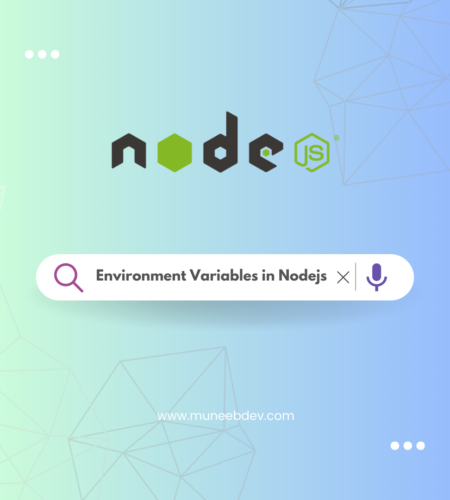In the world of software development, configuration management plays a crucial role in ensuring that applications are secure, scalable, and easy to deploy. Environment variables are a cornerstone of this configuration management, offering a way to externalize configuration data from the application code. This blog explores environment variables in Node.js, their importance, best use cases, common mistakes developers make, and how to use them effectively.
What Are Environment Variables?
Environment variables are key-value pairs used to store configuration settings for applications. These variables are typically defined outside the application and can be accessed by the application at runtime. This allows developers to:
- Separate configuration from the codebase.
- Use different configurations for development, testing, and production environments.
- Securely manage sensitive information such as API keys, database credentials, and access tokens.
Environment Variables in Node.js
In Node.js, environment variables can be accessed via the process.env object, which is globally available. Each property of process.env represents an environment variable that is defined in the operating system or set explicitly for the Node.js application.
Example:
const dbHost = process.env.DB_HOST;
console.log(`Database Host: ${dbHost}`);If DB_HOST is set in the environment, this code snippet will print its value. If not, undefined will be returned.
Setting Environment Variables
There are several ways to set environment variables in Node.js:
1. Using Shell/Command Line
You can define environment variables directly in the shell or command line before running your application.
Example (Linux/Mac):
export DB_HOST=localhost
node app.jsExample (Windows):
set DB_HOST=localhost
node app.js2. Using a .env File
For local development, you can use a .env file to define environment variables. This file is typically stored in the root of your project.
Example .env file:
DB_HOST=localhost
DB_USER=root
DB_PASS=secretYou can load these variables into your Node.js application using the dotenv package.
Installation:
npm install dotenvUsage:
require('dotenv').config();
const dbHost = process.env.DB_HOST;
console.log(`Database Host: ${dbHost}`);3. Setting Variables in Deployment Environments
For production, environment variables are often managed by the deployment platform (e.g., AWS, Heroku, Docker).
Example (Heroku):
heroku config:set DB_HOST=localhostWhen to Use Environment Variables
Best Scenarios for Using Environment Variables
- Sensitive Information
- Store API keys, database credentials, or third-party service tokens.
- Environment-Specific Configurations
- Use different configurations for development, testing, and production environments, such as URLs, ports, or feature toggles.
- Feature Flags
- Enable or disable features in different environments.
- Application Secrets
- Manage secrets that should not be hardcoded, such as encryption keys or tokens.
- Dynamic Configurations
- Allow applications to adapt to different deployment environments without changing the codebase.
When Not to Use Environment Variables
- Large Configurations: Avoid using environment variables for extensive data configurations, such as JSON objects or long strings.
- Frequent Updates: Configuration values that change frequently might be better suited for database or configuration management tools.
Common Mistakes Developers Make with Environment Variables
1. Hardcoding Sensitive Values
Developers sometimes hardcode sensitive values into the codebase, defeating the purpose of environment variables. This can lead to security breaches if the code is exposed.
Solution: Always use environment variables for sensitive data and avoid hardcoding them in the code.
2. Pushing .env to Version Control
Accidentally committing the .env file to version control can expose sensitive information to anyone with access to the repository.
Solution: Add .env to the .gitignore file and double-check before committing changes.
3. Using Inconsistent Naming
Inconsistent naming conventions (e.g., dbHost, DB_HOST, DbHost) can lead to confusion and errors.
Solution: Adopt a clear and consistent naming convention, such as using uppercase letters with underscores (e.g., DB_HOST).
4. Missing Default Values
Applications might crash if required environment variables are not set.
Solution: Use default values or validate variables at application startup.
Example:
const dbHost = process.env.DB_HOST || 'localhost';5. Using Environment Variables for Large or Complex Data
Storing large or complex data (e.g., JSON objects) in environment variables can lead to errors and maintenance issues.
Solution: Use environment variables for simple key-value pairs and store large data in configuration files or databases.
6. Not Validating Environment Variables
Applications might behave unpredictably if required variables are not set or are invalid.
Solution: Use libraries like joi or envalid to validate environment variables.
Example:
const requiredEnvVars = ['DB_HOST', 'DB_USER', 'DB_PASS'];
requiredEnvVars.forEach((varName) => {
if (!process.env[varName]) {
throw new Error(`Missing required environment variable: ${varName}`);
}
});Securing Environment Variables
Managing sensitive environment variables securely is critical. Here are some strategies:
- Use Secrets Management Tools Tools like AWS Secrets Manager, HashiCorp Vault, or Azure Key Vault can securely store and manage sensitive information.
- Encrypt Variables For added security, encrypt sensitive variables before storing them and decrypt them in the application.
- Restrict Access Limit access to environment variables to only those who need it, and ensure proper role-based access control.
Testing Environment Variables
For testing, mock environment variables to simulate different configurations.
Example with Jest:
process.env.DB_HOST = 'test_host';
// Run tests
console.log(process.env.DB_HOST); // Output: test_hostConclusion
Environment variables are an essential tool for managing application configuration in Node.js. By following best practices, avoiding common pitfalls, and securing sensitive information, you can create scalable, maintainable, and secure applications. Understanding when and how to use environment variables ensures that your applications are robust and adaptable to different environments. Adopt environment variables in your workflow today to simplify configuration management and improve your application’s portability.


Comments